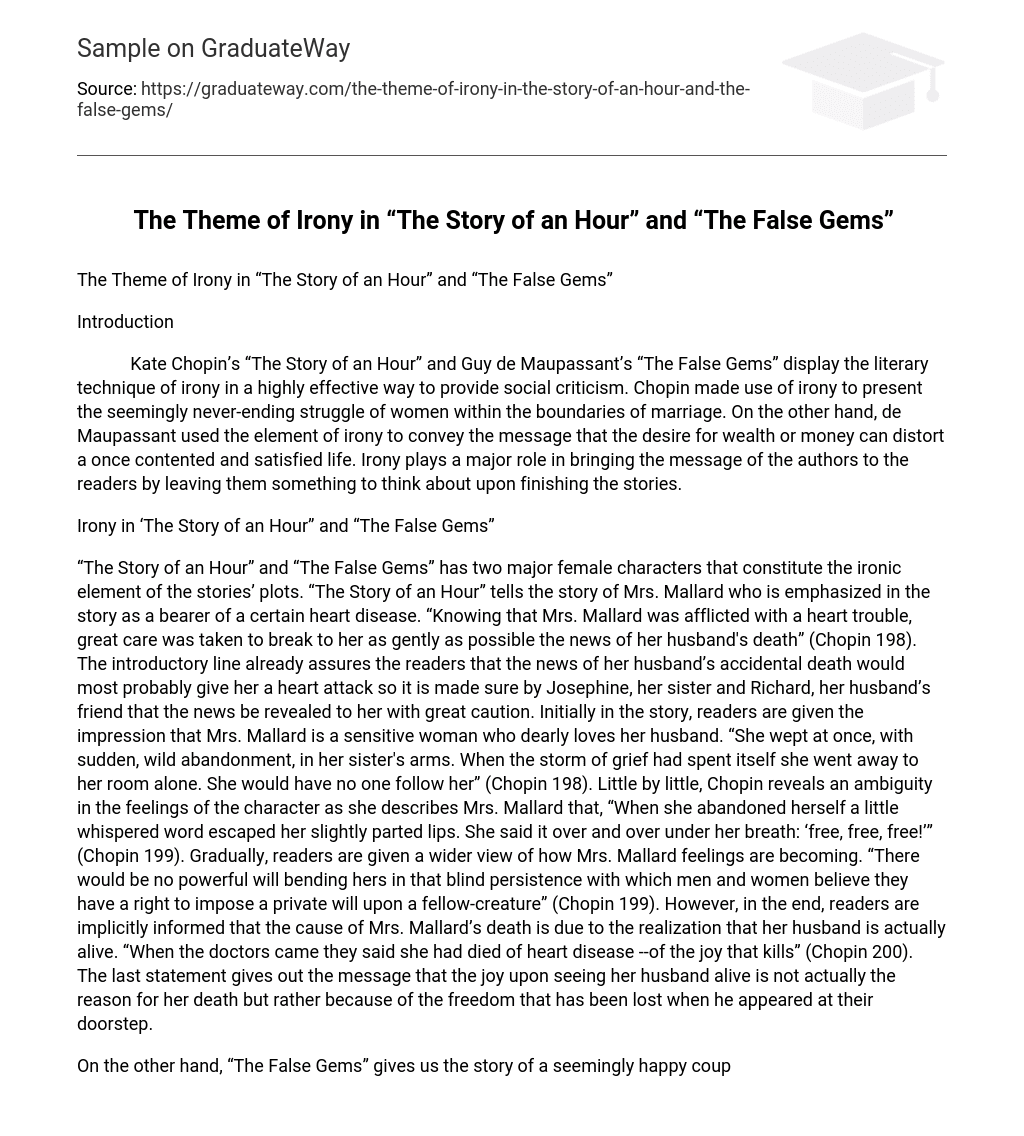Introduction
Kate Chopin’s “The Story of an Hour” and Guy de Maupassant’s “The False Gems” display the literary technique of irony in a highly effective way to provide social criticism. Chopin made use of irony to present the seemingly never-ending struggle of women within the boundaries of marriage. On the other hand, de Maupassant used the element of irony to convey the message that the desire for wealth or money can distort a once contented and satisfied life. Irony plays a major role in bringing the message of the authors to the readers by leaving them something to think about upon finishing the stories.
Irony in ‘The Story of an Hour” and “The False Gems”
“The Story of an Hour” and “The False Gems” has two major female characters that constitute the ironic element of the stories’ plots. “The Story of an Hour” tells the story of Mrs. Mallard who is emphasized in the story as a bearer of a certain heart disease. “Knowing that Mrs. Mallard was afflicted with a heart trouble, great care was taken to break to her as gently as possible the news of her husband’s death” (Chopin 198). The introductory line already assures the readers that the news of her husband’s accidental death would most probably give her a heart attack so it is made sure by Josephine, her sister and Richard, her husband’s friend that the news be revealed to her with great caution. Initially in the story, readers are given the impression that Mrs. Mallard is a sensitive woman who dearly loves her husband. “She wept at once, with sudden, wild abandonment, in her sister’s arms. When the storm of grief had spent itself she went away to her room alone. She would have no one follow her” (Chopin 198). Little by little, Chopin reveals an ambiguity in the feelings of the character as she describes Mrs. Mallard that, “When she abandoned herself a little whispered word escaped her slightly parted lips. She said it over and over under her breath: ‘free, free, free!’” (Chopin 199). Gradually, readers are given a wider view of how Mrs. Mallard feelings are becoming. “There would be no powerful will bending hers in that blind persistence with which men and women believe they have a right to impose a private will upon a fellow-creature” (Chopin 199). However, in the end, readers are implicitly informed that the cause of Mrs. Mallard’s death is due to the realization that her husband is actually alive. “When the doctors came they said she had died of heart disease –of the joy that kills” (Chopin 200). The last statement gives out the message that the joy upon seeing her husband alive is not actually the reason for her death but rather because of the freedom that has been lost when he appeared at their doorstep.
On the other hand, “The False Gems” gives us the story of a seemingly happy couple where the wife, Madame Lantin is described to be an avid collector of jewelry imitations which Monsieur Lantin despises. The first half of the story reveals how Monsieur Lantin is extravagantly happy and contented with his wife. He finds her to be the ultimate source of his joy. “He was unspeakably happy with her. She governed his household with such clever economy that they seemed to live in luxury” (de Maupassant 365). The only problem that he has with her is her passionate enjoyment in theatre and desire for fake jewelries. Her wife is so into them that she describes it to be her only weakness. “It is my only weakness. We cannot change our nature” (de Maupassant 365). The irony in this story is evident upon Madame Lantin’s death. When Monsieur Lantin begins to desire for due to his debts and present impoverished life, he starts selling the “fake jewelries” of his late wife to find out that they are actually real gems. The irony lies on the fact that the thing that he most despises in his wife for its fraudulence is the thing that would bring him real material wealth. However, despite his wealth and marriage to a much virtuous woman, the story concludes how his life turns sorrowful. “Six months afterward, he married again. His second wife was a very virtuous woman; but had a violent temper. She caused him much sorrow” (de Maupassant 368).
Chopin and de Maupassant’s stories consist of ironic situations which are quite similar in terms of criticizing the social structure of their time. Chopin attacked the unjust position of women in marriage while de Maupassant targeted the misery that desire for money can bring. Both of these messages are effectively conveyed by the use of irony in the stories. It is effectively delivered in a way that the readers are forced to ponder about these realizations in the end. Irony solidifies the two stories’ plot and conflicts. Instead of just leaving another story in the readers’ minds, they are given thoughts to ponder with regards to the social issues which are evident in the society.
Conclusion
It is also important to note that the themes implied in the stories are still applicable in our resent society. Women’s struggle for fair treatment in a marriage and the evil that comes out of the love for money are two societal issues which are still resent today. Clearly, the use of irony in the stories of Chopin and de Maupassant made it easier for readers to spend some time to think about these things. After reading, readers are left with realizations of these social issues which are illustrated in more meaningful way with the help of ironic situations in the stories.
Works Cited
Chopin, Kate. “The Story of an Hour.” The Awakening and Selected Stories of Kate Chopin. Ed. Barbara H Solomon. New York: Signet Classic, 1976. 198-200.
De Maupassant, Guy. “The False Gems.” The Entire Original Maupassant Short Stories. Trans. Albert M. C. McMaster, A. E. Henderson. NuVision Publications, LLC, 2007. 365-368.





